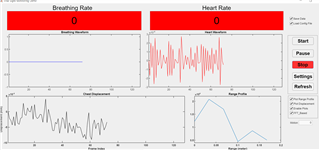Other Parts Discussed in Thread: IWR1443
Hi,
We have an IWR1443BOOST mm-wave radar sensor.
We were collecting data using this radar sensor with Vital Sign Demo Software.
In our notion, there should not be any peak in the Range Profile plot, when there is no person in front of the radar. But to our surprise, we were getting peaks in the Range profile even if there is no one in front of the radar (please refer to the attached figure).
Our query is that is this behavior of the radar okay or not okay?
Moreover, if some corrections are required, then what is the process to do it?
Kindly suggest and help us.

Thanking you
Amit


